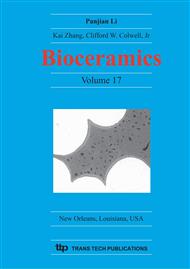p.251
p.255
p.259
p.263
p.267
p.271
p.277
p.281
p.285
Preparation of Bioactive Titanium Alloy Implant and Its Histological Examination
Abstract:
A layer of thick oxide film was formed on Ti6Al4V substrate by anodization. Subsequently alkali and heat treatment induced to form bonelike apatite layer on its surface in SBF for 7 days. The performances of the implants in vivo were observed by naked eyes and H.E. staining technique. The bone tissues around the surface and interface of the specimen in treated Ti6Al4V group were formed more quickly than those in Ti6Al4V and 316L alloy groups. H.E staining results of treated Ti6Al4V group showed the development of newly formed bone tissues on the implant-bone interface area.
Info:
Periodical:
Pages:
267-270
Citation:
Online since:
April 2005
Authors:
Keywords:
Price:
Сopyright:
© 2005 Trans Tech Publications Ltd. All Rights Reserved
Share:
Citation:


